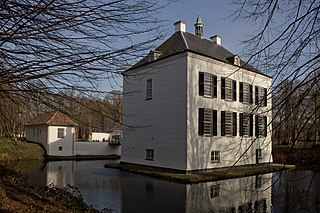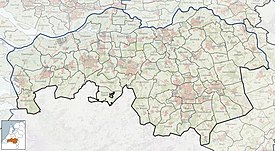
Tuyll is the name of a noble Dutch family, with familial and historical links to England, whose full name is Van Tuyll van Serooskerken. Several knights, members of various courts, literary figures, generals, ambassadors, statesmen and explorers carried the family name.

Heeze Castle is situated in the Netherlands, south of Eindhoven. It used to be the centre of the seigneury of Heeze, Leende and Zesgehuchten, part of the Duchy of Brabant. In the Middle Ages, it was owned by the de Horne family. In the seventeenth Century Pieter Post designed a new castle, of which the first part was built in 1665. After Pieter Post died, the work was completed by his son Maurits Post.

Heeswijk Castle is a moated castle near Heeswijk in the Dutch province of North Brabant.

Samuel Ernest "Sammy", Baron van Tuyll van Serooskerken is a Dutch politician and a member of the Dutch nobility. He was co-founder of the Liberal Democratic Party and was head of list for this party in the 2006 and 2012 Parliament elections.

Poeke Castle is a castle near Poeke, a small town in the municipality of Aalter in the Belgian province of East Flanders. The castle, standing in 56 hectares of park, is surrounded by water and is accessible through bridges at the front and rear of the building. Poeke Castle is situated at an elevation of 15 meters.

John II, Lord of Polanen was Lord of Polanen, Lord of De Lek and Lord of Breda.
John of Horne, lord of Baucignies, was an Admiral of Flanders.

Oud Herlaer was a castle on the Dommel just east of Vught. All that remains is a farm which incorporates parts of the old castle. While not that much remains of the castle, there are a lot of recent studies about Oud Herlaer and its owners. The farm is planned to be opened as an art center in 2021. The name Oud Herlaer,, signifies that later on Nieuw-Herlaer Castle was built about 1 kilometer upstream.

Bokhoven Castle was a big defendable castle in Bokhoven, the Netherlands. A moat and part of the northern wall of the outer bailey are all that reminds of the castle.

Loon op Zand Castle, is a castle in Loon op Zand, in the Dutch province of North Brabant. The current building looks like a manor, but is actually the keep of a medieval castle.

Meerwijk Castle is a Tudor Revival Style mansion on the east bank of the Dieze river just north of 's-Hertogenbosch. It was preceded by Meerwijk Manor, built on the same location.

Aldendriel Castle is late medieval castle in Mill, North-Brabant, Netherlands

Dussen Castle is a water castle that got its peculiar form after being destroyed by the St. Elizabeth's flood of 1421.

Willem IV of Horne (1303–1343) was Lord of Altena, Weert, Nederweert, Wessem, Heeze, Leende, and Cortessem. From his niece Beatrice of Leuven he inherited Gaasbeek, Leeuw, Herstal and Montcornet.

Gerard II of Horne was a medieval nobleman.

Willem V of Horne was a medieval nobleman.

Dirk Loef of Horne was a medieval nobleman.

Willem VI of Horne was a Dutch Nobleman, the Lord of Horne.

Altena Castle is a former castle in Almkerk. It was home to the lords of Altena, and often of the lords of Horne and Altena.

Sint-Maartensdijk Castle was a castle with a rich history. Except for a part of the moats nothing remains of it.




















